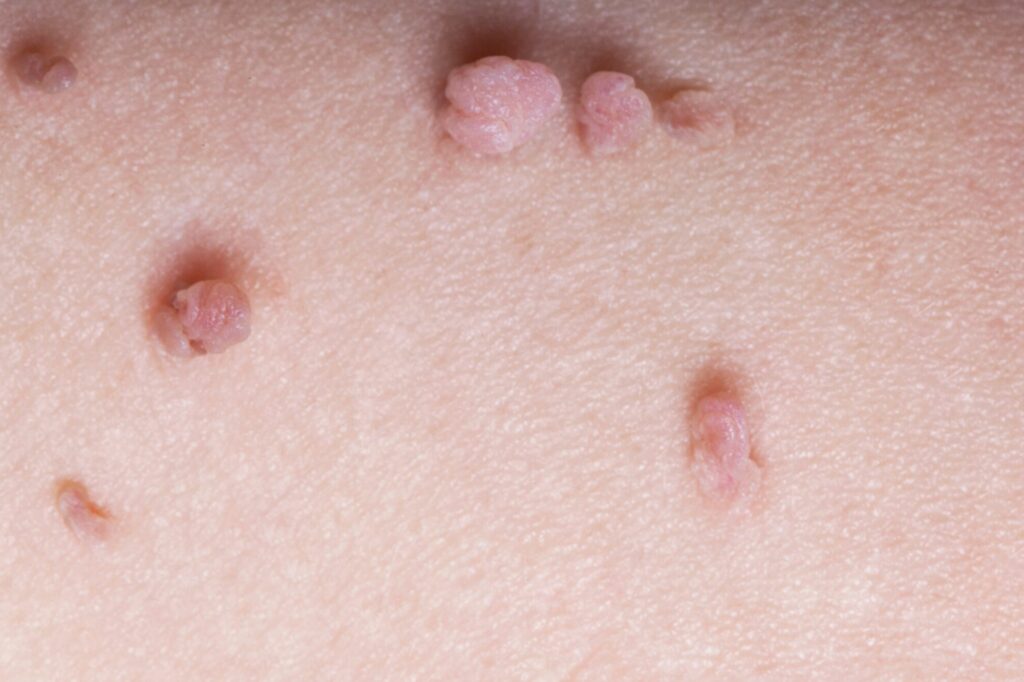Tag out your unwanted skin tags.
Skin tag removal is a cosmetic procedure that involves removing small, benign growths known as skin tags. Skin tags are soft, flesh-colored or slightly darker growths that commonly occur in areas where the skin folds or rubs together, such as the neck, armpits, groin, and under the breasts.

Methods of Skin Tag Removal
Cryotherapy: This method involves freezing the skin tag with liquid nitrogen, causing it to fall off over time.
Excision: Surgical excision involves cutting the skin tag off with a scalpel or surgical scissors.
Benefits of Skin Tag Removal
Cosmetic Improvement: Removal of skin tags can improve the overall appearance of the skin, especially in visible areas. This can boost self-esteem and confidence.
Prevention of Irritation: Skin tags can sometimes become irritated or caught on clothing and jewelry, leading to discomfort. Removal eliminates the risk of irritation.
Enhanced Comfort: Skin tags in areas of friction, such as underarms or the groin, can cause discomfort. Removing them can improve comfort and prevent chafing.
Prevention of Bleeding or Inflammation: Skin tags may bleed or become inflamed, especially if they are accidentally scratched or irritated. Removal eliminates the risk of these complications.
Avoidance of Cosmetic Discomfort: Skin tags, especially if large or in visible areas, can be a cosmetic concern. Removing them can prevent any potential discomfort related to their appearance.
Ease of Skincare: Skin tags can interfere with skincare routines, making it challenging to apply creams or lotions. Removal allows for a smoother and more comfortable skincare routine.
Improved Hygiene: Skin tags in areas where moisture accumulates may lead to hygiene challenges. Removal improves hygiene in these areas.
Quick and Low-Risk Procedure: Skin tag removal is a quick and generally low-risk procedure that can often be done in a dermatologist’s office. It usually involves minimal downtime.
Medical Evaluation: During the removal process, the healthcare provider can evaluate the skin tag to ensure it is indeed benign and not a more serious skin condition.
Skin Tag Treatment Areas
Skin Tag Pre-Care Instructions
Consultation with a Healthcare Professional: Schedule a consultation with one of our providers to assess the skin tags, discuss your concerns, and determine the most appropriate removal method.
Provide Medical History: Share your complete medical history, including any existing medical conditions, allergies, or medications you are currently taking. This information helps the healthcare professional ensure the safety of the procedure.
Inform About Pregnancy: If you are pregnant or breastfeeding, inform your healthcare provider. While skin tag removal is generally safe, special considerations may be needed during pregnancy.
Avoid Sun Exposure: Limit sun exposure and tanning in the areas where skin tags are present. Sunburned or tanned skin may be more sensitive, and avoiding sun exposure helps minimize the risk of complications.
Discontinue Blood-Thinning Medications: If approved by your healthcare provider, consider discontinuing blood-thinning medications or supplements (such as aspirin or fish oil) a few days before the procedure. This can help reduce the risk of bleeding.
Hydrate the Skin: Keep the skin well-hydrated by using a gentle moisturizer. Hydrated skin can be more pliable, making the removal process smoother.
Avoid Harsh Skincare Products: Refrain from using harsh skincare products, exfoliants, or retinoids on the skin tags for at least one week before the procedure. These products may increase skin sensitivity.
Avoid Self-Removal: Resist the temptation to attempt self-removal of skin tags at home. DIY methods may lead to infection, scarring, or other complications.
Follow Provider’s Instructions: If your healthcare provider provides specific pre-care instructions, such as using a prescribed topical cream, follow their recommendations diligently.
Comfortable Clothing: Wear loose, comfortable clothing on the day of the procedure, especially if the skin tags are in areas where clothing may rub.
Communicate Concerns: If you have any concerns or questions about the procedure, anesthesia, or aftercare, communicate them with your healthcare provider during the consultation or before the procedure.
Skin Tag Post-Care Instructions
After skin tag removal, it’s important to follow post-care instructions to ensure proper healing and minimize the risk of complications. Here are general post-care instructions for skin tag removal:
Keep the Area Clean: Gently clean the treated area with mild soap and water. Pat the area dry with a clean, soft towel. Avoid rubbing or scrubbing the area.
Avoid Moisture: Keep the treated area dry and avoid excessive moisture. Refrain from swimming, hot tubs, or prolonged exposure to water for a few days after the procedure.
Skip Harsh Skincare Products: Avoid applying harsh skincare products, exfoliants, or retinoids to the treated area for at least a week after removal. These products may irritate the healing skin.
Apply an Antibiotic Ointment: If recommended by your healthcare provider, apply an over-the-counter antibiotic ointment to the treated area. This can help prevent infection and promote healing.
Avoid Touching or Scratching: Refrain from touching or scratching the treated area to prevent irritation and reduce the risk of infection. Let the skin heal naturally.
Avoid Sun Exposure: Protect the treated area from direct sunlight. If exposure is unavoidable, apply a broad-spectrum sunscreen with a high SPF to prevent sun damage.
Avoid Tight Clothing: Wear loose-fitting clothing to avoid friction and irritation in the treated area. This is especially important if the skin tags were removed from areas where clothing may rub.
Watch for Signs of Infection: Monitor the treated area for any signs of infection, such as increased redness, swelling, pain, or discharge. If you notice these symptoms, contact your healthcare provider promptly.
Follow Provider’s Recommendations: Adhere to any specific post-care recommendations provided by your healthcare provider. This may include using prescribed medications or following a customized care routine.
Pain Management: If you experience mild discomfort or pain, you can take over-the-counter pain relievers as directed by your healthcare provider. Avoid aspirin if you were instructed to discontinue blood-thinning medications before the procedure.
Attend Follow-Up Appointments: Attend any follow-up appointments scheduled by your healthcare provider. These appointments allow them to assess the healing process and address any concerns.
Be Patient: Allow time for the treated area to heal. Healing times may vary, but skin tag removal procedures typically involve minimal downtime.
Frequently asked questions
Book Your Skin Tag Treatment Today
Book your skin tag removal appointment in Pensacola, FL, and speak to one of our trained providers to learn more.
